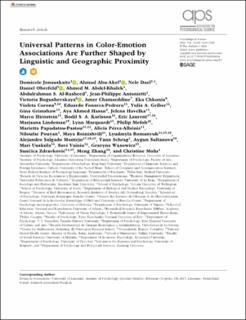| dc.contributor.author | Jonauskaite, Domicele | |
| dc.contributor.author | Abu-Akel, Ahmad | |
| dc.contributor.author | Dael, Nele | |
| dc.contributor.author | Oberfeld, Daniel | |
| dc.contributor.author | Abdel-Khalek, Ahmed M. | |
| dc.contributor.author | Al-Rasheed, Abdulrahman Saud | |
| dc.contributor.author | Antonietti, Jean-Philippe | |
| dc.contributor.author | Bogushevskaya, Victoria | |
| dc.contributor.author | Chamseddine, Amer | |
| dc.contributor.author | Chkonia, Eka | |
| dc.contributor.author | Corona, Violeta | |
| dc.contributor.author | Fonseca-Pedrero, Eduardo | |
| dc.contributor.author | Griber, Yulia A. | |
| dc.contributor.author | Grimshaw, Gina M. | |
| dc.contributor.author | Hasan, Aya Ahmed | |
| dc.contributor.author | Havelka, Jelena | |
| dc.contributor.author | Hirnstein, Marco | |
| dc.contributor.author | Karlsson, Bodil S.A. | |
| dc.contributor.author | Laurent, Eric | |
| dc.contributor.author | Lindeman, Marjaana | |
| dc.contributor.author | Marquardt, Lynn Anne | |
| dc.contributor.author | Mefoh, Philip | |
| dc.contributor.author | Papadatou-Pastou, Marietta | |
| dc.contributor.author | Pérez-Albéniz, Alicia | |
| dc.contributor.author | Pouyan, Niloufar | |
| dc.contributor.author | Roinishvili, Maya | |
| dc.contributor.author | Romanyuk, Lyudmyla | |
| dc.contributor.author | Salgado-Montejo, Alejandro | |
| dc.contributor.author | Schrag, Yann | |
| dc.contributor.author | Sultanova, Aygun | |
| dc.contributor.author | Uusküla, Mari | |
| dc.contributor.author | Vainio, Suvi | |
| dc.contributor.author | Wąsowicz, Grażyna | |
| dc.contributor.author | Zdravković, Sunčica | |
| dc.contributor.author | Zhang, Meng | |
| dc.contributor.author | Mohr, Christine | |
| dc.date.accessioned | 2021-06-28T11:08:16Z | |
| dc.date.available | 2021-06-28T11:08:16Z | |
| dc.date.created | 2020-09-28T12:11:23Z | |
| dc.date.issued | 2020 | |
| dc.identifier.citation | Psychological Science, 2020, 31(10), 1245–1260 | en_US |
| dc.identifier.issn | 0956-7976 | |
| dc.identifier.uri | https://hdl.handle.net/11250/2761614 | |
| dc.description.abstract | Many of us “see red,” “feel blue,” or “turn green with envy.” Are such color-emotion associations fundamental to our shared cognitive architecture, or are they cultural creations learned through our languages and traditions? To answer these questions, we tested emotional associations of colors in 4,598 participants from 30 nations speaking 22 native languages. Participants associated 20 emotion concepts with 12 color terms. Pattern-similarity analyses revealed universal color-emotion associations (average similarity coefficient r = .88). However, local differences were also apparent. A machine-learning algorithm revealed that nation predicted color-emotion associations above and beyond those observed universally. Similarity was greater when nations were linguistically or geographically close. This study highlights robust universal color-emotion associations, further modulated by linguistic and geographic factors. These results pose further theoretical and empirical questions about the affective properties of color and may inform practice in applied domains, such as well-being and design. | en_US |
| dc.language.iso | eng | en_US |
| dc.publisher | Sage | en_US |
| dc.subject | Affect | en_US |
| dc.subject | Color perception | en_US |
| dc.subject | Cross-cultural | en_US |
| dc.subject | Universality | en_US |
| dc.subject | Cultural relativity | en_US |
| dc.subject | Pattern analysis | en_US |
| dc.subject | Open data | en_US |
| dc.subject | Open materials | en_US |
| dc.title | Universal patterns in color-emotion associations are further shaped by linguistic and geographic proximity | en_US |
| dc.type | Journal article | en_US |
| dc.type | Peer reviewed | en_US |
| dc.description.version | publishedVersion | en_US |
| dc.source.pagenumber | 1245–1260 | en_US |
| dc.source.volume | 31 | en_US |
| dc.source.journal | Psychological Science | en_US |
| dc.source.issue | 10 | en_US |
| dc.identifier.doi | 10.1177/0956797620948810 | |
| dc.identifier.cristin | 1834160 | |
| cristin.ispublished | true | |
| cristin.fulltext | original | |
| cristin.qualitycode | 2 | |
